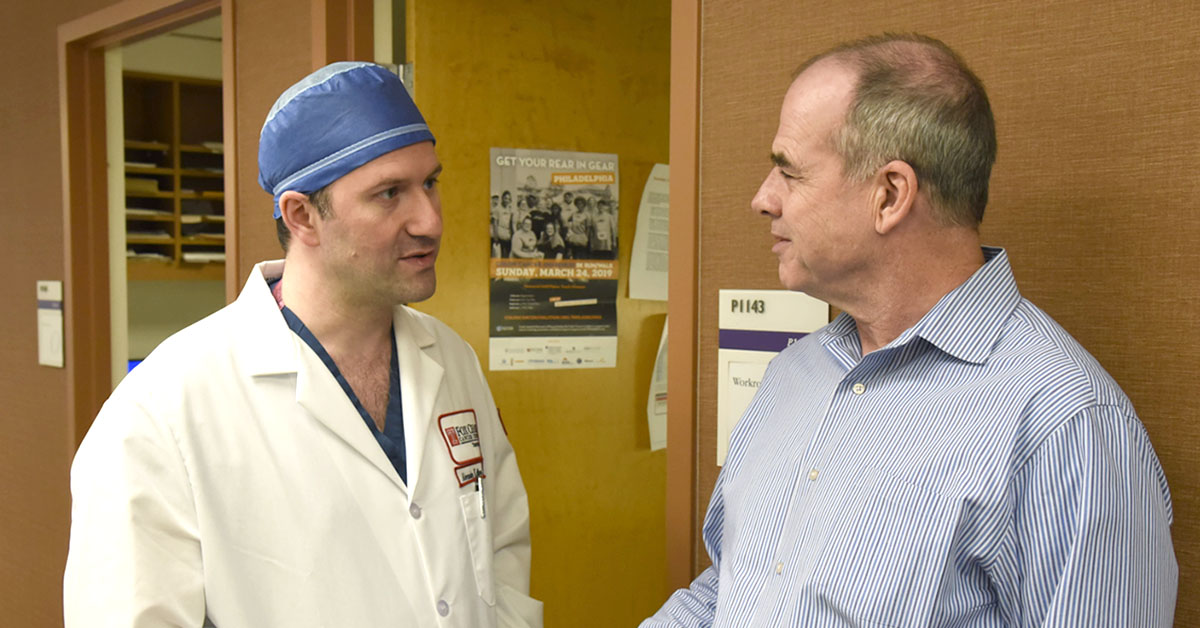
Less Can Mean More When it Comes to Treating Some Cases of Prostate and Bladder Cancer
-
Less can sometimes mean more. And over the last decade, this principle has been increasing in popularity when approaching treatment for some types of cancer; bladder and prostate cancer being two of them.
Treatment approaches for bladder and prostate cancers have undergone rapid evolution in the last few years, including the addition of “de-escalation” approaches. For some patients it is possible to safely delay or avoid surgery entirely all while maintaining positive outcomes. Fox Chase Cancer Center physicians and researchers are at the forefront of utilizing these approaches and share some of the lessons they are learning when it comes to offering some patients an alternative to life-changing surgeries and treatment.
The benefits of active surveillance for prostate cancer
Active surveillance for prostate cancer has become a reality for more men in recent years as diagnostic techniques and and the ability to more clearly define a patient’s risk have improved, says Alexander Kutikov, MD, FACS, chief of the Division of Urology and Urologic Oncology at Fox Chase.
“For patients whose physicians are using active surveillance to monitor their disease, the chance of dying from untreated prostate cancer is one in a thousand, which is similar to the chances of dying from similar risk prostate cancer if it was treated,” Kutikov notes.
Some of the key points in favor of active surveillance include:
- Active surveillance is safe and patients will get treatment if it is truly needed.
- Patients can put off or forego side effects for a number of years without impacting their survival rate.
- Active surveillance gives patients the option for safer and better therapies in the future as the field rapidly changes.
Recent advances in diagnostic and treatment technologies are making active surveillance safer and even more effective. For example, Fox Chase uses the latest MRI and ultrasound image scanning techniques to improve assessment of prostate tumors to determine how aggressive the cancer is. A second example is that some select patients who previously developed infections from transrectal biopsy procedures may be eligible for the alternative technique of transperineal biopsy to reduce infection risk. Finally, recently developed genetic assessments of tumor samples can help evaluate the cancer’s long-term risk.
More options to treat prostate cancer with localized therapy
Another novel treatment option for some men diagnosed with prostate cancer is focal therapy, which destroys small areas of localized, clinically concerning prostate cancer in a highly targeted way. Real-time transrectal ultrasound guidance allows close monitoring during the procedure and avoids unneeded treatment to the normal prostate and surrounding structures, all of which minimize the side effects of this therapy.
Focal therapy has several benefits:
- Few side effects and minimal negative impact on urinary, bowel, and sexual function
- Fast recovery time and minimal blood loss
- It does not preclude future definitive treatment
Clinical trials paving the way for new treatment options for bladder cancer
While a cystectomy or bladder removal surgery is the recommended standard of care for muscle-invasive bladder cancer (MIBC) because it cures the disease, ongoing clinical trials are exploring whether avoiding surgery or radiation altogether may be a safe alternative for select patients who have undergone chemotherapy prior to surgery.
Fox Chase medical oncologist Daniel M. Geynisman, MD, is researching this idea in a clinical trial entitled, “A Phase II Trial of Risk Enabled Therapy After Initiating Neoadjuvant Chemotherapy for Bladder Cancer (RETAIN BLADDER).”
Individualized therapy for each patient is the goal. In the study, the researchers are applying a risk-adapted approach that identifies genetic mutations in cancer cells to predict whether chemotherapy will be effective in eliminating all cancer and preventing recurrence or cancer that spreads from the initial site to lymph nodes or other structures.
Qualifying patients with promising biomarkers, meaning that their body is reacting positively, and who are also clinically cancer-free after their chemotherapy but before they have had their surgery, are put on an active surveillance protocol for close monitoring of their progress. That spares them the quality-of-life side effects common with the removal of the bladder or radiation.
“Developing predictive biomarkers to understand who does or does not respond to chemotherapy can let us apply our treatment recommendations in a more nuanced way,” Geynisman says. He notes that chemotherapy followed by surgery has been proven to improve survival and remains the gold-standard for all eligible patients with MIBC.
Another clinical trial — “Assessment of Reliability of Cystoscopic Evaluation Predicting pT0 Urothelial Carcinoma of the Bladder at the Time of Radical Cystectomy” — is developing a risk classification tool by learning why don’t always find muscle-invasive bladder cancer (MIBC), says study leader Kutikov.
The researchers are developing standardized descriptions as well as a map and scoring system that physicians can use when they inspect the inside of the bladder for tumors using a cystoscope. They are also investigating whether key indicators in patient urine could be used to identify those with MIBC after chemotherapy who should still have their bladder removed.
“We hope these RETAIN BLADDER and MIBC clinical trials will give new perspectives on effective bladder cancer treatment and the traditional standard-of-care recommendations,” says Kutikov. “By combining clinical data with molecular or genomic data and taking a risk-balanced approach based on different genetic markers in muscle-invasive bladder cancer, our goal is to enable doctors to make smarter decisions with their patients about cystectomies and, when possible, spare them from the life-changing procedure.”
Historically, the common approach has been more is best. Now, with new advancements and more diagnostic tools, we are better able to personalize treatment to the individual and their specific type of cancer. And we’re learning: More isn’t always better.
